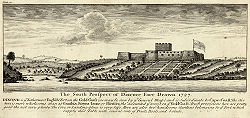| Fort Metal Cross | |
|---|---|
| Part of British Gold Coast | |
 Fort Metal Cross in 1727. | |
| Location | |
| Coordinates | 4°47′36″N1°56′41″W / 4.79321°N 1.94484°W |
| Site history | |
| Built | 1683 |
| Garrison information | |
| Occupants | Britain (1683-1868) Netherlands (1868-1872) |
| Location | Dixcove, Western Region, Ghana |
| Part of | Forts and Castles, Volta, Greater Accra, Central and Western Regions |
| Criteria | Cultural: (vi) |
| Reference | 34-008 |
| Inscription | 1979 (3rd Session) |
Fort Metal Cross, originally Fort Dixcove, is a military structure located on a promontory at the fishing community of Infuma in Dixcove, in the Western Region of Ghana. [1] Because of its history in the Atlantic slave trade and its testimony to European-African trade, the Fort was included as one of the Forts and Castles of Volta, Greater Accra, Central and Western Regions that became a World Heritage Site in 1979. [2]















